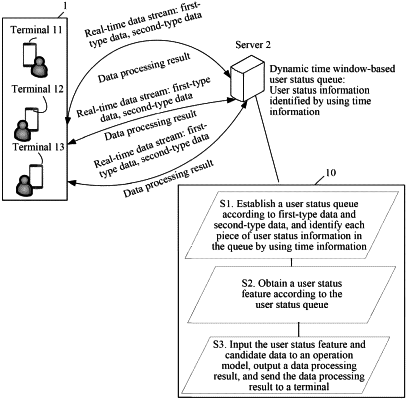| CPC G06F 16/9535 (2019.01) [G06F 16/00 (2019.01); G06F 16/2365 (2019.01); G06F 16/2465 (2019.01); G06F 16/24568 (2019.01); G06F 2216/03 (2013.01)] | 20 Claims |

|
1. A data processing method, comprising:
collecting, by a server, a real-time data stream, the real-time data stream including a plurality of usage data for a plurality of content, each of the plurality of usage data indicating (i) content identification information of a respective one of the plurality of content, (ii) one of a plurality of user actions that is performed on the respective one of the plurality of content, and (iii) a time stamp of the respective user action, each of the plurality of user actions being assigned to a behavior weight;
generating a user status queue according to the plurality of usage data and the content identification information of the plurality of content, each of a plurality of queue elements of the user status queue including a respective one of the plurality of usage data and the content identification information indicated by the respective one of the plurality of usage data, the user status queue being arranged based on the time stamps of the plurality of user actions indicated by the plurality of usage data;
limiting the generated user status queue by
limiting a length of the generated user status queue by removing usage data having an earliest time stamp from the user status queue when a number of queue elements in the generated user status queue exceeds a threshold number, and
limiting a validity duration of the generated user status queue by removing, from the user status queue, all usage data in which a difference between first time information of the respective usage data and current time information is greater than a validity duration threshold, wherein the removing all usage data outside the validity duration threshold is performed independently of the length of the user status queue;
determining a user status feature according to the content identification information indicated by usage data included in the limited user status queue and the behavior weights assigned to the user actions indicated by the usage data included in the limited user status queue;
determining recommended information according to the user status feature; and
sending the recommended information to a user terminal.
|